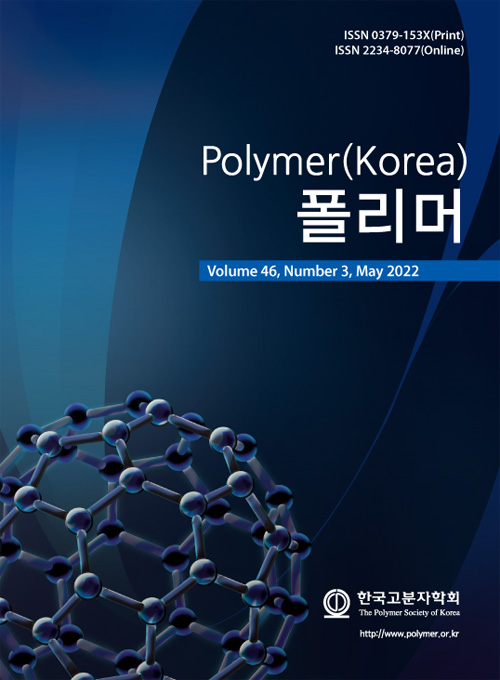- Characteristics of a Halloysite Filled Epoxy Resin System
Department of Chemical Engineering, Chungbuk National University, 1 Chungdaero, Seowongu, Cheongju, Chungbuk 28644, Korea
- 할로이사이트 충전 에폭시 수지 계의 특성
충북대학교 공과대학 화학공학과
Reproduction, stored in a retrieval system, or transmitted in any form of any part of this publication is permitted only by written permission from the Polymer Society of Korea.
In this study, neat halloysite nanotube (HNT) and HNT treated with an aqueous NaOH solution (0.01 M or 5 M) were used as nanofillers. A typical diglycidyl ether of bisphenol A (DGEBA) epoxy resin was mixed with 0-4 phr HNT then an anhydride curing agent and an imidazole-based catalyst were used to prepare epoxy-HNT nanocomposites by curing. Mechanical properties of the epoxy-HNT nanocomposites were measured by impact tester and universal testing machine and curing behavior and thermal properties of them were investigated by DSC. HNT treated with 0.01 M aqueous NaOH solution was most effective in improving the mechanical properties of the epoxy-HNT nanocomposites. With increasing HNT content, the peak temperature of the DSC exothermic curve decreased but the exothermic reaction heat almost unchanged. The epoxy-HNT nanocomposite containing 2 phr of HNT treated with 0.01 M NaOH aqueous solution showed the best mechanical properties and the highest glass transition temperatur.
본 연구에서는 순수한 할로이사이트 나노튜브(HNT)와 NaOH 수용액(0.01 M 또는 5 M)으로 처리한 HNT를 나노충전제로 사용하였다. 전형적인 diglycidyl ether of bisphenol A(DGEBA) 에폭시 수지에 0-4 phr의 HNT를 혼합하고 무수물 경화제와 이미다졸 기반 촉매로 경화하여 에폭시-HNT 나노복합재를 제조하였다. 에폭시-HNT 나노복합재의 기계적 특성은 충격시험기 및 만능재료시험기로 측정하였고 경화 거동 및 열적 특성은 DSC로 조사하였다. 0.01 M NaOH 수용액으로 처리한 HNT가 에폭시-HNT 나노복합재의 기계적 특성 향상에 가장 효과적이었다. HNT 함량이 증가함에 따라 에폭시 수지 계의 DSC 발열곡선의 피크 온도는 낮아졌으나 발열반응열은 거의 변화가 없었다. 0.01 M NaOH 수용액으로 처리한 HNT를 2 phr 함유한 에폭시-HNT 나노복합재가 가장 우수한 기계적 특성 및 높은 유리전이온도를 보였다.
Keywords: epoxy, halloysite nanotube, nanocomposites, mechanical properties, thermal properties.
- Polymer(Korea) 폴리머
- Frequency : Bimonthly(odd)
ISSN 0379-153X(Print)
ISSN 2234-8077(Online)
Abbr. Polym. Korea - 2023 Impact Factor : 0.4
- Indexed in SCIE
 This Article
This Article
-
2022; 46(3): 361-368
Published online May 25, 2022
- 10.7317/pk.2022.46.3.361
- Received on Jan 21, 2022
- Revised on Feb 15, 2022
- Accepted on Feb 24, 2022
 Correspondence to
Correspondence to
- Dae Su Kim
-
Department of Chemical Engineering, Chungbuk National University, 1 Chungdaero, Seowongu, Cheongju, Chungbuk 28644, Korea
- E-mail: dskim@cbnu.ac.kr









 Copyright(c) The Polymer Society of Korea. All right reserved.
Copyright(c) The Polymer Society of Korea. All right reserved.